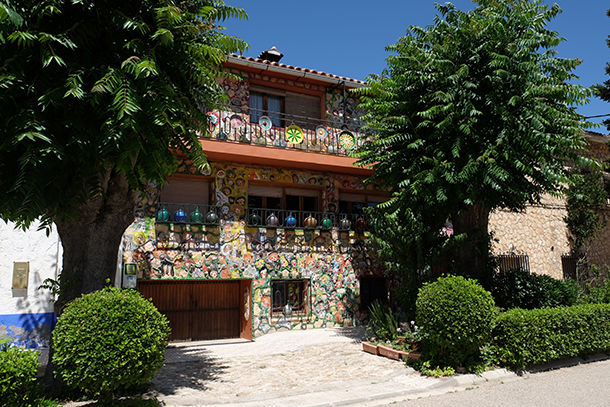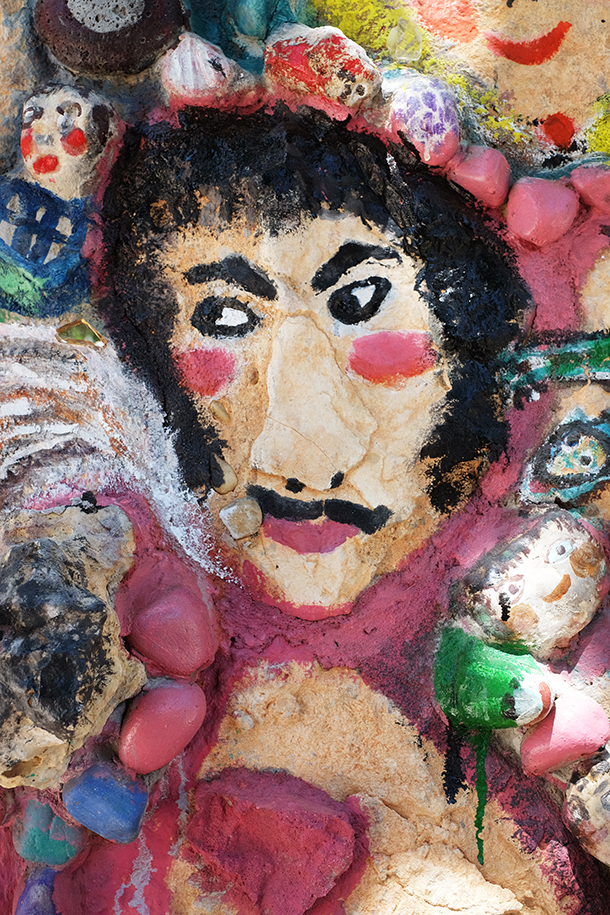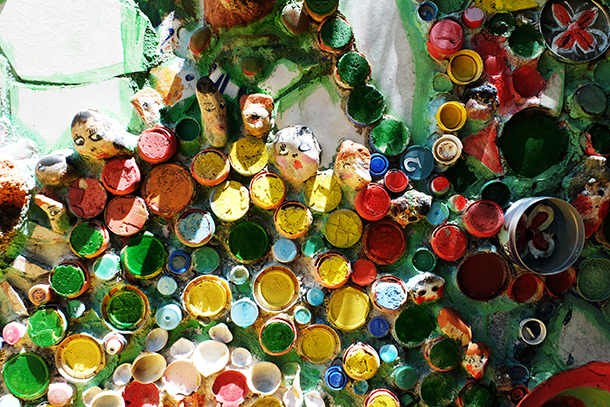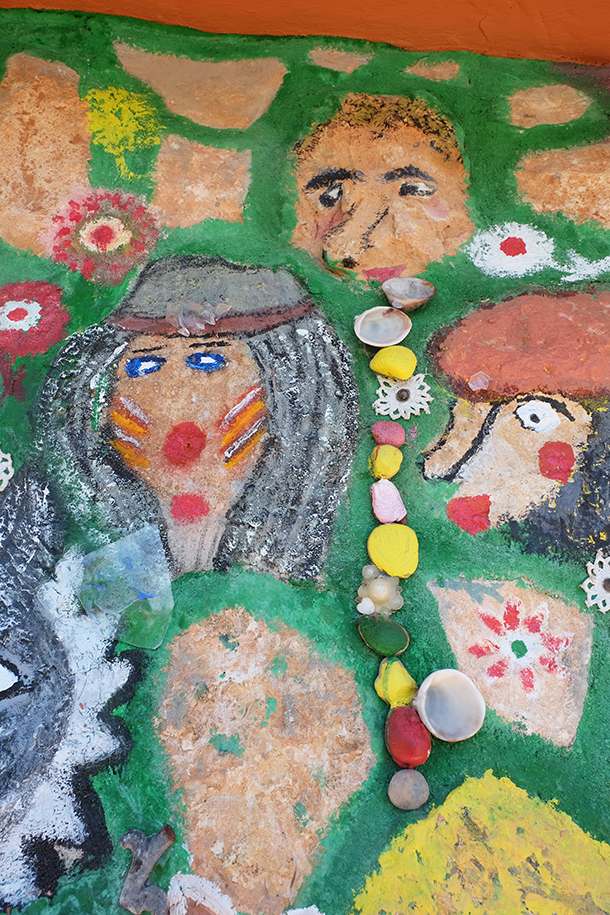
IN A SMALL TOWN, AN ENTERPRISING SELF-TAUGHT ARTIST TRANSFORMS HER HOME INTO A “HOUSE OF FACES”
Based in northern California, where she taught art history and ran the campus gallery for many years at San José State University, while also serving as the executive director and curator of SPACES Archives, a nonprofit organization dedicated to documenting and advocating for artist-built environments on a global scale, Jo Farb Hernández has spent almost five decades researching environments created by visionary self-taught artists.
Over the past 20-plus years, she has concentrated on such site-specific works across Spain’s varied terrain. Her book about this subject, Singular Spaces: From the Eccentric to the Extraordinary in Spanish Art Environments, was published in 2013.
For brutjournal, Hernández has dipped into her notebooks and her documentation of the art environments of Spain’s many self-taught artists. Based on her primary field work, this is the fourth of her reports in a series examining some of those art-makers’ unusual creations. Expanded versions of these articles, as well as her research about 95 other Spanish art-environment builders, will appear in a book that is scheduled to be published by 5 Continents Editions in 2023.
by Jo Farb Hernández
Esther Mena Pérez (born February 9, 1932)
Location of her art environment: El Provencio, Province of Cuenca, Autonomous Community of Castilla-La Mancha, central Spain
Even the most “liberated” women in Spain faced severely restricted opportunities during the period of the nation’s brutal civil war (1936-39) and subsequent decades of the 20th century, as the vision of a culturally homogeneous and patriarchal society promulgated by the fascist government of Francisco Franco wiped out women’s prospects for economic and social advancement, and potential, liberal-minded solutions for coping with such challenging situations, including divorce, contraception, or abortion, were absolutely prohibited. Hand in hand with the Roman Catholic Church, the concept of an ideal Spain put forth by Franco’s Nationalist regime favored men — in particular, those of an elevated social class.

In such a society, a woman who attempted to help support her family without obtaining her father’s or husband’s permission to do so could find herself facing serious legal complications. It was even more difficult for women who wanted to express themselves creatively, particularly in ways that challenged mainstream ideas regarding what art should look like and where it should exist.
Self-censorship and passive acceptance of conformist cultural judgments were powerful measures that discouraged female artists and, of course, severely diminished the possibility that any woman might have the wherewithal to create something monumental enough to be regarded as or to become an art environment.
Esther Mena, the third of four children, was born and went to school in the small town of El Provencio in the Province of Cuenca, which today is part of the Autonomous Community of Castilla-La Mancha in central Spain. In addition to basic academic subjects, a girl’s education when Mena was growing up was weighted with such pursuits as sewing and embroidering, for the acquisition of such skills was considered important for future homemakers.
One of young Esther’s teachers, who promoted art in terms of its relationship to housekeeping, greatly influenced her; many years later, the artist recalled that, from this time on, she “really dedicated herself to art.” Even today, without making a distinction regarding genres that were once referred to as “women’s work,” Mena continues sewing and embroidering as part of her diverse art practice.

Mena married Hernán Arenas, a municipal-government administrator, and frequently took her four sons out into the countryside as they were growing up. During such outings, they played games, and she urged them to join her in gathering interesting-looking rocks; after they returned home, Mena painted faces on some of them and then placed her painted rocks as decorations around the homes in which her family lived over the years as they moved from place to place to follow Arenas’s career. But her husband died at the age of 56, and Esther, who was four years younger, was left to bring up her four sons on her own.
Her husband’s sudden death radically changed her approach to living. Shortly thereafter, upon losing her parents as well, Mena inherited half of their house and then hired contractors to remodel it while still maintaining the original structure’s pressed-clay and stone walls. Given the conventional use in her region of small stones in building as well as her earlier use of painted rocks to decorate her home, it was not a stretch for her to consider ornamenting her house’s renovated façade with such material.
So, as the contractors refurbished and modernized her house in the mid-1980s, she asked them to randomly insert some extra stones protruding from its façade. Some were stones she already had painted, while others would serve as new, additional surfaces that she could later embellish.

Mena enrolled in painting and ceramics classes in Villarobledo, a nearby town, and, as a student, interpreted some of Spanish art’s most famous paintings, such as Velázquez’s “Las Meninas” (1656), while she also explored Picasso-influenced designs in her work with clay. However, her teacher urged her to instead invent her own images. So she began adding texture to her canvases, and her range of imagery exploded beyond genre scenes and still lifes to include stylized figures and metaphorical portraits whose nominally unadventurous subjects became increasingly subsumed by an intense, painterly approach.
In such works, Mena built up relief surfaces that pushed the limits of two dimensions and, enthusiastically experimenting with greater depth, glued found objects to her paintings’ substructures. The resulting exaggerated forms frequently eclipsed any conventionality her subjects might originally have had.
This two-dimensional and bas-relief work both referred to and further inspired Mena’s ornamentation of her home, and, over the years, she has gone far beyond conventional decorating to create what has become a compelling art environment. While she also painted a variety of animals and birds, Mena primarily saw human faces on the surfaces of her house’s stone façade, so she outlined and filled in these images, guided by the shapes of the stones themselves. Next, she began filling in the spaces between the protruding, painted stones, inserting additional faces and larger blocks of color to balance and frame them. If she ran out of rocks to paint, she would jump on her bicycle and head out to nearby fields to gather more.

To complement the rocks that had been added by the builders as an integral part of her renovated house’s exterior walls, she affixed additional, smaller rocks and pebbles. However, she had much to learn about technical processes; at the outset, she used plaster to attach the smaller stones, but that material dissolved in the rain. She was more successful later with a mixture of cement and sand, which provided a stronger, more durable adhesive. At first she mixed small batches of her own mortar in a bucket but soon she was able to buy pre-mixed blends.
In time, Mena’s colorfully decorated house became known among the locals as “La Casa de las Caras” (“The House of Faces”). “Every one has its own expression,” the artist has noted, referring to her painted images. While each is different, many share the same kinds of stylized treatments that are typically found in illustrations made by some young girls, reflecting their naïve, glamorized ideas of beauty.
In her painted faces, for example, Mena generally renders the corneas of eyes round and white, enclosing black pupils that often appear to be looking off flirtatiously to one side. Typically, she depicts female faces with bright red lips and circles for rosy cheeks, two small black dots to indicate noses, and helmet-like heads of hair (which, often, are blond or red, colors that are rarely found in Spain without chemical processing).

As the outlines of Mena’s faces follow the irregular shapes of the stones, they cozy up to each other in a seemingly random fashion, with no evidence of thematic or narrative connections. They may also abut images of animals, birds, fish, or insects, which can be identified by their whiskers, snouts, pointed ears, fins, or antennae.
Still other images appear to be amalgams of several or completely imaginary creatures, such as a rabbit-snail-cat hybrid that can be seen on the second level of the front façade of the artist’s house. Some of Mena’s human heads are ornamented with such fashionable accoutrements as a colorful painted necklace, a hair bow, or a hat made from a porcelain fragment. She cheerfully played with form, texture, and scale as if they were one of her favored games.

Mena’s most interesting painted faces do not follow such image-idealizing conventions, however. In these, she takes advantage of the natural concavities and irregularities of her stones’ more uneven shapes and surfaces to create images that look misshapen and asymmetrical, even as they make use of her familiar color scheme. In these faces, noses might appear to be inverted rather than protruding, heads may be contorted, chins might be nonexistent or overly prominent, and sometimes only a single eye is visible on a face. These works are significantly more riveting — and unsettling — than her more symmetrical compositions.
Later, Mena expanded her efforts by ornamenting her house’s interior, ground-floor patio. There, where smoother, broader wall surfaces form an enclosed space, she painted faces on rocks and affixed them to the walls. She added a variety of found objects as well, including broken porcelain plates or terra-cotta storage jugs and pieces of glass. Neighbors gave her old, hand-blown glass jugs, some of which she painted; she also collected empty plastic containers, aluminum cans, remnants of plastic tubing, and much more. In bright displays of color and texture, she arranged some along the walls in asymmetrical geometries and threaded others through the branches of the trees growing within the patio space.
Around 2019, Mena’s doctors advised her to cut back on the physical labor she was putting into artistically decorating her house. Although she chafed in reaction to those restrictions, she now obediently spends more of her time reading, arranging flowers, and sewing and embroidering bedspreads and curtains. This new activity has altered her daily rhythm, the artist complains, but she remains passionate about her work and eager to share it, and she still has additional adornments she would like to complete, including painting part of her house’s front door and windows. Referring to her creative drive and ambition, Mena says that she is “just like a bug that doesn’t stop.”

Esther Mena came of age during the tumult of Spain’s bloody civil war and World War II. Although the early years of her life were marked by the deep social and cultural conservatism of another era, over the decades her inherent resourcefulness and bold approach to life have served her well, as in the face of national and personal trauma she daringly transformed her private living space. Such an artistic undertaking had never been seen before in this region of Spain’s heartland.
Remarkably, she managed to carry out her ambitious creative project while still meeting her neighbors’ expectations regarding her proper role and behavior in society — about, for example, the homemaking tasks she should perform and the responsibilities she should shoulder as a wife and mother.
Although, to date, her artistic achievement has not yet become widely known, with praise from her four sons and recognition from her community, Mena has found personal satisfaction, a sense of fulfillment, and great pleasure in using natural and found objects from her environs to create a unique and special art environment in the middle of a small Manchegan town.

Author’s note: Thanks to Mena’s son, Fernando, for introducing me to his mother’s work, and to Fernando, David, and César for follow-up e-mail correspondence and fact-checking during the course of my research and writing.



